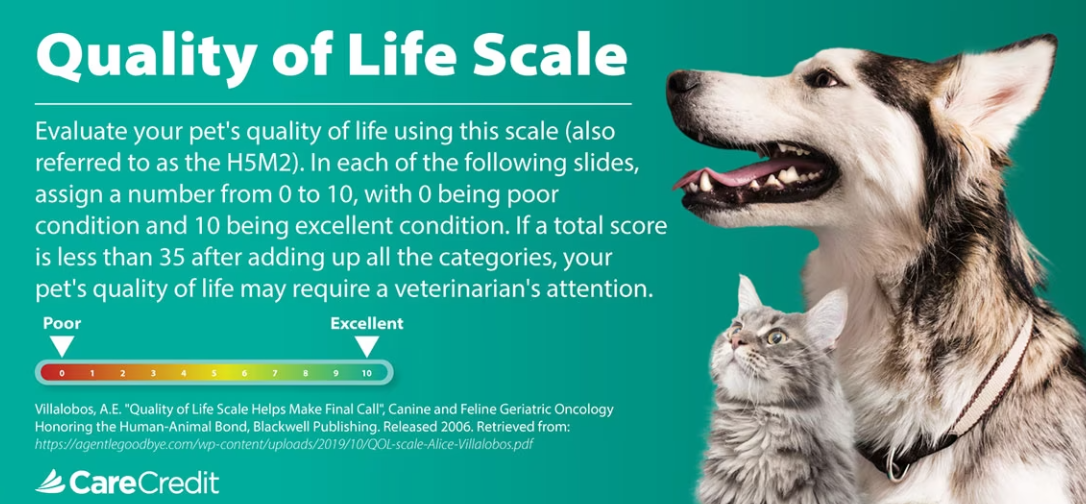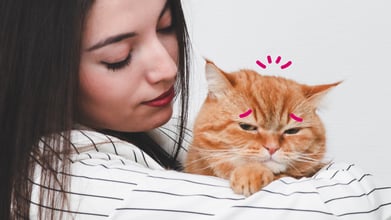Compassionate Cat Hospice Care: Creating Comfort at Home

Table of Contents
As a veterinarian at BetterVet, I see firsthand the heartache pet parents experience when their cat's health declines. It's a deeply emotional time, and you naturally want to do everything you can to ensure your furry friend's comfort. Palliative care for cats, also known as hospice care, can be a valuable option in these situations.
In this blog post, I will answer the following questions: What exactly is cat hospice care? I will also explore how to create a palliative care plan for your feline companion at home. As well as touch on the sensitive topic of euthanasia so that you can make informed decisions with your veterinarian.
Key Takeaways:
-
Hospice care (palliative care) offers compassionate support for cats nearing the end of life, focusing on comfort and quality of life.
-
Terminal illness, age-related decline, or chronic conditions that interfere with your cat’s routine could indicate hospice care is an option.
-
Work with your veterinarian to create a personalized plan, schedule checkups, and make informed decisions about your cat's end-of-life care.
What is Cat Hospice Care
Cat hospice care, or palliative care, focuses on improving your cat's quality of life during their end-of-life stages. This approach applies whether your cat is facing a terminal illness, a chronic condition, or the natural aging process.
The American Association of Feline Practitioners (AAFP) strongly supports this compassionate approach, recognizing its ability to enhance a pet's well-being in their final days.
Unlike a physical hospice location, in-home palliative care is a personal decision rooted in accepting death as natural. Working with your veterinarian, you can actively participate in your cat's care, ensuring their comfort and well-being.
Through pain management, special diets, and loving care, a hospice plan can support your cat’s comfort level at home.
Ongoing Care and Comfort Considerations
Knowing how to keep your cat comfortable during hospice care is essential. This section explores various factors that impact their well-being and quality of life, helping you create a loving and supportive environment.
Severity of Condition
Patient comfort must always be considered when hospice and palliative care are provided. Many conditions or disease processes, such as cancer or kidney failure, can develop at any age, impacting a cat's ability to live comfortably.
Senior or geriatric cats are more likely to require hospice care, and the severity of their condition significantly impacts their well-being and quality of life (QOL).
Quality of Life Scale
A quality-of-life assessment is a tool used to determine a cat's well-being on a scale of 0 to 10. Veterinarians and pet parents use a combination of subjective and objective criteria to evaluate QOL.
Here are some cat well-being factors that are considered:
-
Physical: Mobility and activity level, appetite, hydration, pain level, respiratory function, cardiovascular function, grooming and coat condition
-
Emotional: Behavior and temperament, interaction with family members and other pets, enjoyment of favorite activities or hobbies, Signs of anxiety, stress, or depression
-
Social: Socialization and bonding with family members (when a healthy human-animal bond is no longer achievable). Response to environmental enrichment or changes in routine: If changes or enrichment or routine create stress, anxiety, distance.
-
Environmental: Access to food, water, litter box, resting areas, and their ability to reach these areas; exposure to stressors such as loud noise or unfamiliar animals or people. Cats in compromised states need a quiet, calm environment.
-
Medical: Not responding to pain management or therapies to improve comfort can affect quality of life. Ineffective treatment for the progression of illness can affect quality of life.
If a cat is experiencing more bad days than good, then QOL is being affected.

Making a Palliative Care Plan
Working with your veterinarian, you can address essential aspects of managing your cat's condition through a personalized palliative care plan.
Pain and Medication Management
It is imperative that pain is controlled. Medications play a crucial role in pain management and maintaining appetite, hydration, and mobility, all of which contribute to your cat's well-being.
A cat must be able to take these pain medications and supportive measures comfortably and with minimal stress for both you and your feline companion.
Is Your Cat Showing Signs of Osteoarthritis Pain?
1. Has difficulty jumping up or down.
2. Trouble climbing up stairs - your cat may stop halfway or “bunny hops” with both back legs at the same time.
3. Difficulty getting down the stairs - your cat may angle their body or go down one step at a time.
4. Less interest in playing/chasing - your cat may avoid active play or take frequent breaks.
5. Avoids running - your cat moves at a slower speed and alternates running with walking.
6. Changes in appetite - your cat is showing less interest in food.
7. Changes in grooming - your cat is not grooming as much as usual or is overgrooming certain areas.
8. Personality changes - your cat is less sociable than usual, is hiding more, or is resistant to being touched.
9. Changes in potty habits - your cat is having accidents inside the house or not using the litter box.
View Results
Is Your Cat Showing Signs of Osteoarthritis Pain?
1. Has difficulty jumping up or down.
2. Trouble climbing up stairs - your cat may stop halfway or “bunny hops” with both back legs at the same time.
3. Difficulty getting down the stairs - your cat may angle their body or go down one step at a time.
4. Less interest in playing/chasing - your cat may avoid active play or take frequent breaks.
5. Avoids running - your cat moves at a slower speed and alternates running with walking.
6. Changes in appetite - your cat is showing less interest in food.
7. Changes in grooming - your cat is not grooming as much as usual or is overgrooming certain areas.
8. Personality changes - your cat is less sociable than usual, is hiding more, or is resistant to being touched.
9. Changes in potty habits - your cat is having accidents inside the house or not using the litter box.
Share Quiz
Veterinary Support
The veterinarian and care team provide expertise in palliative care and pain management. Their support includes:
-
Regular visits: Weekly to every two weeks, depending on the severity of the cat’s condition
-
Education and guidance: The veterinarian and team will educate owners about the cat's health, disease process, and severity.
-
Evaluating your cat’s well-being: You will learn how to evaluate pain levels and QOL and recognize signs of decline
-
Comfort care at home: The veterinarian will guide you on providing comfort and essential hospice care at home, including:
-
Maintaining social interactions with family
-
Keeping clean, soft bedding and proper thermal support if needed
-
Ensuring easy access to food, water, litter boxes, and comfortable beds
-
Preventing potential dangers like falls, temperature fluctuations, parasite prevention, bed sores
-
Maintaining patient cleanliness
-
Preventing pain
-
The veterinarian will also help you recognize and communicate when your cat's QOL is declining. Together, you can make realistic assessments of what can be provided through hospice and palliative care with patients’ interests in mind.
This includes considering ethical, moral, and welfare considerations, understanding your needs and beliefs, and recognizing that each family has their own personal lifestyle and tolerance level.
Emotional Support
Hospice care acknowledges the deep bond between you and your cat, recognizing the emotional impact alongside physical needs. Resources are available to help you navigate this difficult time, including grief counseling (online or local community) and emotional support from friends, hospice advisors, psychologists, social workers, volunteers, and spiritual advisors.
Considering Euthanasia
As your cat receives palliative care, there may come a time when a difficult decision needs to be made. In determining whether your cat's quality of life (QOL) is compromised, you will want to consider the following:
-
Loss of basic functions: Unable to reach food, water, litter box, or maintain social interaction.
-
Uncontrolled pain: Despite medication, pain interferes with daily life.
-
Difficulty with supportive measures: Administering medication becomes too stressful for both the cat and the owner.
-
Respiratory distress: Difficulty breathing becomes a constant struggle.
-
Increased anxiety and stress: Hiding, distancing, or uncontrolled restlessness indicate significant emotional distress.
Conclusion
Cat hospice care at home allows you to maintain your furry companion’s routine and comfort level while managing their pain, appetite, and mobility. If you're unsure about your cat's well-being or have concerns, don't hesitate to schedule a quality-of-life consultation with BetterVet.
Stress-Free Vaccinations for Your Furry Friend
Get your pet vaccinated in their favorite spot - at home. No need to hassle with carriers or car rides.
Frequently Asked Questions
Will my cat pass away peacefully at home on their own?
While some cats may pass away peacefully at home, it is important to work with a veterinary care team closely to help recognize when QOL is declining, and humane euthanasia is needed to prevent patient suffering.
Is there grief counseling available for pet owners?
Yes, there are pet loss resources available to owners who have lost a beloved companion.
Sources:
-
Eigner, D. R., Breitreiter, K., Carmack, T., Cox, S., Downing, R., Robertson, S., & Rodan, I. (2023). 2023 AAFP/IAAHPC feline hospice and palliative care guidelines. Journal of Feline Medicine and Surgery. https://doi.org/10.1177/1098612X231201683
-
Adamelli, S., Marinelli, L., Normando, S., & Bono, G. (2005). Owner and cat features influence the quality of life of the cat. Applied Animal Behaviour Science, 94(1-2), 89-98. https://doi.org/10.1016/j.applanim.2005.02.003






